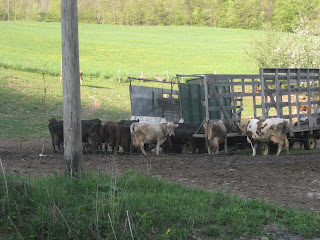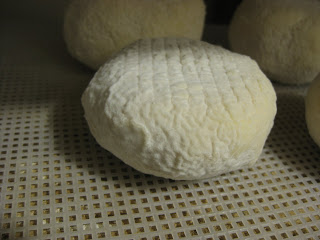
Here is my first attempt of the season to make some goat cheese. Things didn't turn out as hoped for. I had planned to make some lactic acid cheeses. I haven't made any lactic goat cheeses yet and I was quite excited by the prospect. Over the winter I had experimented with cows milk to make this type of cheese, so I was confident I could make this cheese easily from goats milk as this is more of a tradition.
The other day, I was asked "what is lactic type cheese?" These are cheeses made from a curd that is formed by lactic acid bacteria. Sometimes a small amount of rennet is added, depending on the maker's target. The curd formation takes place over a longer period than rennet coagulated cheeses and at a lower temperature. Depending on the temperature the duration can be longer or shorter. The resulting curd is very fragile due to the high Ph of the curd.
For this batch, I poured five gallon of milk into my vat and warmed it up to about 74F. Perhaps I should have paid more attention, because my target temperature was 70F. I had turned the heat under the vat off at about the target temperature but the thick bottom of the vat always retains enough heat to raise the milk another few degrees. Although I was aware of this, I had not anticipated it this time, so ended up with a higher than desired temperature. I thought it would be alright, the coagulation time would just be shorter.
When I checked the curd the next morning after about 10 hours, I was in for a surprise. The curd had started to bubble up and looked like some kind of dough. My son asked whether I tried to make bread. I knew a high temperature could lead to a gassy curd, but I had not expected this to happen at 74. Perhaps the milk contained some organisms that exacerbated the process. The milk was a mixture from the last few days of milking. I don't know how old the oldest milk in the mixture was. Next time I'll ask the people I get the milk from. I will also reread
"The Fabrication of Farmstead Goat Cheese" by Jean-Claude Le Jaouen. This might give me some fresh new insight.
I did let the curd form until my originally planned time and drained it afterwards to still try to make some cheeses out of it. Although I haven't tasted them yet, so far, after a few days, they seem fine. I will post some photographs of them within the next few days. I also retried this procedure with a small amount of milk from the same mix at a lower temperature. Everything seemed to be going fine. Over the next few months, with lots of goat milk expected, I am sure I will get to the bottom of this.

















































